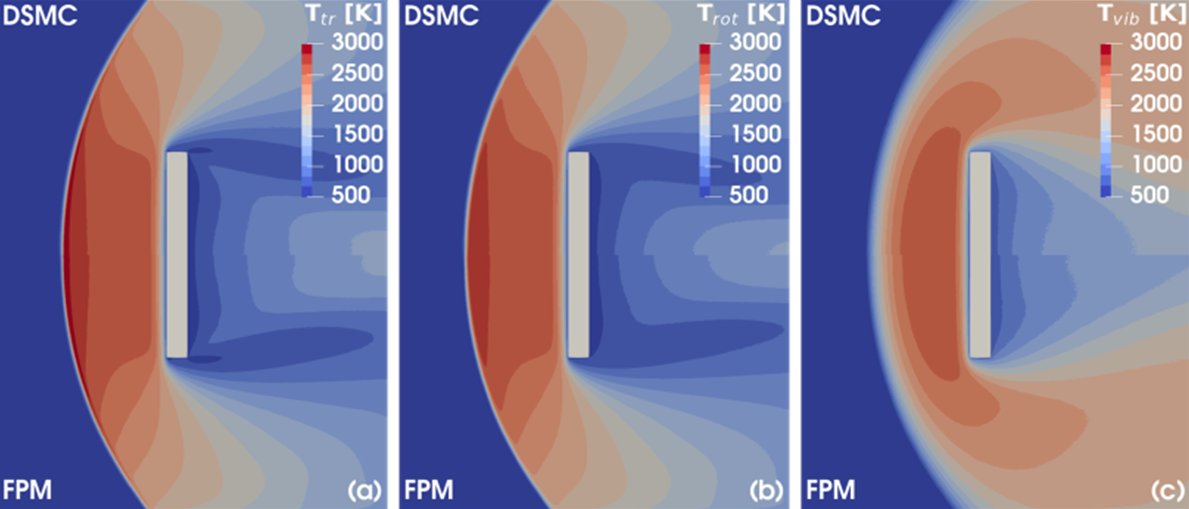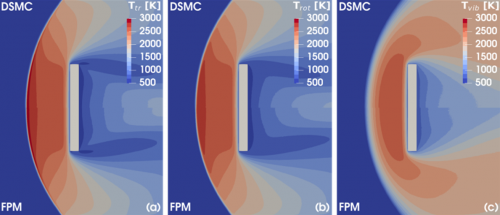Major research outcome
- Ph.D. Candidate Sanghun Kim and Professor Eunji Jun, A Stochastic Fokker-Planck model for diatomic rarefied gas flows: Is particle simulation possible in the continuum regime?
- 관리자 |
- 2024-03-28 16:40:11|
- 304
- 2024-03-28 16:40:11|
When the mean free path of particles is not negligible compared to the characteristic length, the continuum assumption breaks down, and gas flows need to be modeled as a collection of individual particles. The Direct Simulation Monte Carlo (DSMC) method is a standard particle simulation technique for rarefied gas flows. However, for the DSMC method to be effective, the cell size must be smaller than the mean free path, and the time step must be smaller than the mean collision time. These constraints make it difficult to use the DSMC method in multiscale rarefied gas flows that include both low and high densities. Over the past decade, the Particle Fokker-Planck (FP) method has been studied to address computational cost issues in the near-continuum regime. The FP method approximates the discrete binary collision events as continuous drift–diffusion phenomena in velocity space. Since binary collisions are not directly considered, the FP method does not require resolving the length and time scale of collisions. While several monatomic FP models have been proposed, the modeling of diatomic gases within the FP framework has received limited attention so far.
Unlike monatomic gas flows, diatomic gas flows include degrees of rotational and vibrational modes in addition to the translational mode. Furthermore, in the temperature range relevant to aerodynamic engineering, the vibrational energy should be treated as a discrete set of energy levels. Accurate kinetic modeling that satisfies these properties is crucial to correctly describe the non-equilibrium gas flow. Recently, Ph.D. Candidate Sanghun Kim and Professor Eunji Jun have studied a new diatomic Fokker-Planck model that includes major features of the Boltzmann equation. The mathematical properties of this model include the correct Prandtl number, consistent relaxation rates based on the Landau–Teller equation, and the rigorous H-theorem. One reviewer assessed the new diatomic FP model as, “This model comes after a series of models recently proposed in the literature, and it seems to be the most advanced one in terms of physical complexity.” The related paper was published in the Journal of Computational Physics (JCP), volume 506, in 2024. The JCP journal is a reputed research journal that publishes research on advanced numerical modeling in various physics fields.
https://doi.org/10.1016/j.jcp.2024.112940

Figure: Temperature contours around a vertical flat plate (Ma=5, Kn=0.005)
: (a) translational temperature, (b) rotational temperature, and (c) vibrational temperature.
Besides the development of the diatomic FP model, they have studied a broad range of FP methods. Improvements to the monatomic FP model and a comparative study of various FP models were published in Physics of Fluids. The latter features collaboration with Hossein Gorji from Empa, Switzerland. They dream of making a universally efficient and accurate particle solver applicable across all Knudsen numbers.
https://doi.org/10.1063/5.0100633
https://doi.org/10.1063/5.0143195
Unlike monatomic gas flows, diatomic gas flows include degrees of rotational and vibrational modes in addition to the translational mode. Furthermore, in the temperature range relevant to aerodynamic engineering, the vibrational energy should be treated as a discrete set of energy levels. Accurate kinetic modeling that satisfies these properties is crucial to correctly describe the non-equilibrium gas flow. Recently, Ph.D. Candidate Sanghun Kim and Professor Eunji Jun have studied a new diatomic Fokker-Planck model that includes major features of the Boltzmann equation. The mathematical properties of this model include the correct Prandtl number, consistent relaxation rates based on the Landau–Teller equation, and the rigorous H-theorem. One reviewer assessed the new diatomic FP model as, “This model comes after a series of models recently proposed in the literature, and it seems to be the most advanced one in terms of physical complexity.” The related paper was published in the Journal of Computational Physics (JCP), volume 506, in 2024. The JCP journal is a reputed research journal that publishes research on advanced numerical modeling in various physics fields.
https://doi.org/10.1016/j.jcp.2024.112940

Figure: Temperature contours around a vertical flat plate (Ma=5, Kn=0.005)
: (a) translational temperature, (b) rotational temperature, and (c) vibrational temperature.
Besides the development of the diatomic FP model, they have studied a broad range of FP methods. Improvements to the monatomic FP model and a comparative study of various FP models were published in Physics of Fluids. The latter features collaboration with Hossein Gorji from Empa, Switzerland. They dream of making a universally efficient and accurate particle solver applicable across all Knudsen numbers.
https://doi.org/10.1063/5.0100633
https://doi.org/10.1063/5.0143195
| Attach File |
|---|


